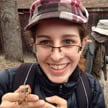-
Asked by Bobby to Lindsay, Jeff on 21 May 2015.0
-
Jeff Shi answered on 21 May 2015:
Find whatever it takes to stay safe, keep others around me safe, but also make sure the dangerous animal/natural feature/whatever also stays safe. It’s a tall order, but as scientists of the natural world it’s also our job to make sure we don’t unecessarily endanger things on accident!
-
-
K. Lindsay Hunter answered on 21 May 2015:
In all of these situations, the best defense is good preparation ahead of time. For instance, when it comes to dealing with wild animals, you try not to get into situations where confrontation would be necessary. This is actually easier than you’d think, since most animals try to stay away from humans. However, a lot of scientists that work with wildlife or out in the bush find themselves in situations like these more often than they like, though still fairly rare. Most times that humans are hurt by animals, the human was doing something that they know they should not have. In general, DO NOT ENGAGE, and for *GOSH* sakes, don’t try to take a selfie with wildlife when you’re out and unprotected! Always be aware of your surroundings and that is the best way to make sure that you don’t get hurt and neither do animals.
There’s not a lot you can do to *defend* yourself against something like a tornado, hurricane, flood, earthquake, wild fire, rock fall, tsunami or something. The best you can hope to do is to try to prepare ahead of time for these. Again, you try to limit your exposure by not living in the most dangerous areas and making sure that you take precautions like having appropriate shelter or an evacuation plan, depending on the kind of risk. Also, DON’T go chasing storms or trying to take selfies in really bad weather–another recipe for disaster!
I’m a big proponent of disaster preparation, and have trained with FEMA, United Animals Nations, and the Human Society of the US in ways to keep your family (and pets–they’re family, too, right?) safe from natural disasters. I even used to volunteer with a group called “Red Rover” that takes care of animals in crisis situations. I was stationed in Cedar Rapids, Iowa during their big flood in 2008, and helped care for the hundreds of dogs and cats left behind in flooded houses, and reunite them with their families.
A lot of this heartache can be avoided, though, by good planning, so check out the resources below and make a plan for YOUR family!
How to Avoid Animal Attacks in a National Park:
http://www.mnn.com/earth-matters/wilderness-resources/stories/how-to-avoid-animal-attacks-in-a-national-parkBear Selfies Could Prove Deadly:
http://www.dailytech.com/Bear+Selfies+Fad+Could+Turn+Deadly+Warn+Nevada+Wildlife+Officials/article36787.htmReady.gov:
http://www.ready.gov/Red Rover Pet Disaster Preparedness:
http://www.redrover.org/pet-disaster-preparedness






Comments